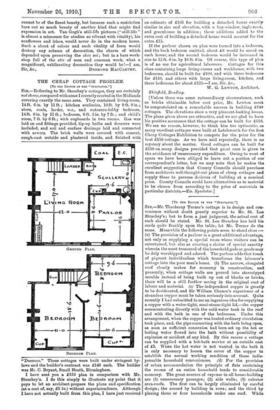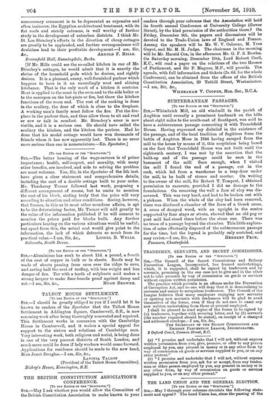pro THE EDITOR OP THE "spEcrirea..1
Thackeray Turner's cottage is in design and con- venience without doubt greatly superior to Mr. St. Loa Strachey's ; but to form a just judgment, the actual cost of each should be stated. Mr. St. Los Strachey has laid his cards quite frankly upon the table ; let Mr. Turner do the same. Meanwhile the following points seem to stand clear
(a) The provision of a parlour is a great additional advantage, not only as supplying a special room where visitors can be entertained, but also as creating a shrine of special sanctity wherein the most treasured of the household gods or goods may be duly worshipped and adored. The parlour adds that touch of piquant individualism which transforms the labourer's cottage into the poor man's home. (b) The narrow, elongated roof clearly makes for economy in construction, and presently, when cottage walls are poured into stereotyped moulds instead of being built up out of blocks or bricks, there will be a still further saving in the original cost of labour and materiaL (c) The independent copper is greatly to be desiderated, and Sir William Chance's experience of a steamleas copper must be taken seriously into account. Quite recently I had submitted to me an ingenious idea for supplying a copper with a water-tight, semi-steam-tight lid,—the copper communicating directly with the cold-water tank in the roof and with the bath in one of the bedrooms. Under this arrangement, when the copper was heated ordinary circulation took place, and, the pipe connecting with the bath being open, as soon as sufficient connexion had been set up the hot or boiling water flowed into the bath without possibility of explosion or accident of any kind. By this means a cottage can be supplied with a hot-bath service at an outside cost of £5. When the hot water is not wanted in the bath it is only necessary to loosen the cover of the copper to establish the normal working condition of these indis- pensable household conveniences. (d) For the provision of urban accommodation the principle of flats containing the rooms of an entire household tends to considerable economy. The great sources of expense in all house-building are (1) unnecessary passages; (2) side walls ; (3) exterior area-roofs. The first can be largely eliminated by careful design ; the second by building in rows ; and the third by placing three or four households under one roof. While unnecessary ornament is to be deprecated as expensive and often insincere, the Egyptian architectural treatment, with its fiat roofs and stately columns, is well worthy of further study in the development of suburban districts. I think Mr. St. Loe Strachey's efforts in the direction of cheap cottages are greatly to be applauded, and further correspondence will doubtless lead to their profitable development.—I am, Sir, ARNOLD F. Hrtr.s. Broomfield Hall, Sunningdale, Berks.
[If Mr. Hills could see the so-called kitchen in one of Mr. Strachey's cottages, he would admit that it is exactly the shrine of the household gods which he desires, and rightly desires. It is a pleasant, sunny, well-furnished parlour which happens to have in it an exceedingly neat and shining kitchener. That is the only mark of a kitchen it contains. Heat is applied to the meat in the oven and to the side boiler or to the saucepan on the hot-plate or fire, but there the kitchen functions of the room end. The rest of the cooking is done in the scullery, the door of which is close to the fireplace. A working man's family must follow the fire. Put the fire- place in the parlour then, and thus allow them to sit and read or sew or talk in comfort. Mr. Strachey's error is now visible, and it is a serious one. He should have called the scullery the kitchen, and the kitchen the parlour. Had he done that his model cottage would have won thousands of friends whom it has now apparently lost. There is no error more serious than one in nomenclature.—En. Spectator.]



















































 Previous page
Previous page